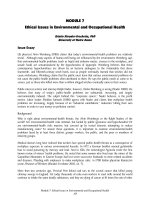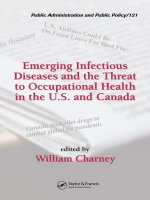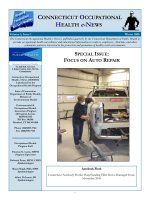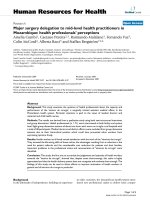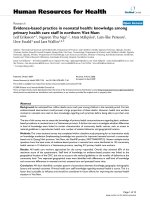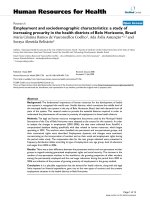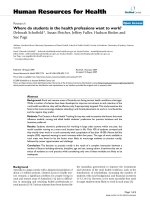NEBOSH international general certificate in occupational health
Bạn đang xem bản rút gọn của tài liệu. Xem và tải ngay bản đầy đủ của tài liệu tại đây (473.12 KB, 66 trang )
November 2014
Guide to the
NEBOSH International
General Certificate in
Occupational Health
and Safety
Qualification title:
NEBOSH International General Certificate in Occupational Health
and Safety
Version: v6
Specification date: November 2014
Guide publication date: November 2018
The National Examination Board in Occupational Safety and Health (NEBOSH),
Dominus Way, Meridian Business Park, Leicester LE19 1QW.
Registered Charity Number: 1010444
Telephone:
Fax:
Email:
Website:
+44 (0) 116 263 4700
+44 (0) 116 282 4000
www.nebosh.org.uk
© NEBOSH
All rights reserved. No part of this publication may be reproduced, stored in a retrieval system or
transmitted in any form, or by any means, electronic, electrostatic, mechanical, photocopied or
otherwise, without the express permission in writing from NEBOSH.
© NEBOSH 2019
Guide to the NEBOSH International General Certificate in
Occupational Health and Safety (November 2014
specification)
Contents
1.
Introduction
1.1
1.2
1.3
1.4
1.5
1.6
1.7
1.8
1.9
1.10
1.11
1.12
1.13
1.14
1.15
1.16
1.17
1.18
1.19
2.
Unit assessment
Unit exemptions
Achieving the qualification
Unit pass standard
Unit certificates
Qualification grades
Qualification parchment
Re-sitting unit/s
7
8
8
8
8
8
8
9
Policies
3.1
3.2
3.3
3.4
4.
1
2
2
2
3
3
3
4
4
4
4
5
5
6
6
6
6
6
6
Qualification structure
2.1
2.2
2.3
2.4
2.5
2.6
2.7
2.8
3.
Benefits for employers
Professional membership
Qualification level and UK accreditation
Key topics covered
Course tuition and private study time requirements
Entry requirements
Minimum standard of English required for candidates
Languages
Legislation
Legislative updates
National Occupational Standards (NOS) and best practice
Qualification type
Qualification progression
Programmes offered by NEBOSH-accredited course providers
Examination dates
Specification date
Syllabus development and review
Further information for candidates
Further information for accredited course providers
Requests for access arrangements/reasonable adjustments
Requests for special consideration
Enquiries about results and appeals
Malpractice
10
10
10
11
Notes for tutors
4.1
4.2
4.3
Tutor references
Teaching of units
Conflict of interest
© NEBOSH 2019
12
12
12
4.4
Minimum standard of English required for tutors
12
5. Syllabus - NEBOSH International General Certificate in Occupational Health and
Safety (November 2014 specification)
13
5.1 Unit IGC1:
Management of international health and safety
Element 1:
Foundations in health and safety
Element 2:
Health and safety management systems - Plan
Element 3:
Health and safety management systems - Do
Element 4:
Health and safety management systems - Check
Element 5:
Health and safety management systems - Act
Unit IGC1: Tutor References
5.2
16
17
19
24
26
28
Unit GC2: Controlling workplace hazards
Element 1:
Workplace hazards and risk control
Element 2:
Transport hazards and risk control
Element 3:
Musculoskeletal hazards and risk control
Element 4:
Work equipment hazards and risk control
Element 5:
Electrical safety
Element 6:
Fire safety
Element 7:
Chemical and biological health hazards and risk control
Element 8:
Physical and psychological health hazards and risk control
Unit GC2: Tutor References
30
33
35
37
39
41
43
46
48
5.3 Unit GC3: Health and safety practical application
5.3.1
5.3.2
5.3.3
5.3.4
5.3.5
5.3.6
6.
Purpose and aim
Marking
Assessment location
Assessment requirements
Submission of completed work
Further information
53
54
54
54
55
55
Sample examination papers
6.1
6.2
Unit IGC1: Management of international health and safety
Unit GC2: Controlling workplace hazards
© NEBOSH 2019
56
59
The Guide to the NEBOSH International General Certificate in Occupational Health
and Safety (November 2014 specification)
1.
Introduction
The International General Certificate in Occupational Health and Safety is suitable for
managers, supervisors and staff based outside the UK from all types of organisations
making day-to-day decisions at work that need a broad understanding of health and safety
issues and be able to manage risks effectively. Over 70,000 people have achieved this
qualification since it was introduced in 2004.
The NEBOSH International General Certificate is also suitable for those embarking on a
career in health and safety, providing a valuable foundation for further professional study
(such as the NEBOSH International Diploma in Occupational Health and Safety).
The International General Certificate is modelled on the NEBOSH National General
Certificate in Occupational Health and Safety, the most widely recognised health and safety
qualification of its kind in the UK. The key difference between the two qualifications is in the
applicability of legal requirements. Rather than being guided by a specifically UK framework,
the International General Certificate takes a risk management approach based on best
practice and international standards, such as International Labour Organisation (ILO) codes
of practice, with special reference to the model proposed in the ILO's "Guidelines on
Occupational Safety and Health Management Systems" (ILO-OSH 2001). Local laws and
cultural factors form part of the study programme where relevant and appropriate.
1.1
Benefits for employers
Despite the increasing global recognition of the importance of health and safety at work,
accidents and work-related ill-health continue to affect all types of workplaces and
occupations.
The
ILO
( estimates that approximately 5,800 people die
daily (approximately one worker dies every 15 seconds) as a result of occupational
accidents or work-related diseases; more than 2.3 million deaths worldwide per year. At
least 14% of these deaths are due to the 317 million accidents at work that occur annually.
There are an estimated 500 –2000 non-fatal injuries for every fatal injury (including 160
million cases of work-related disease), many of which result in lost earnings, lost jobs and
permanent disability and poverty.
In addition to the direct costs of sick pay and absence, employers can find themselves
dealing with criminal prosecution, claims for compensation, adverse publicity and harm to
both business reputation and profitability. In the UK alone, the estimated annual cost of
occupational injury and illness in 2011/12 is £4.3 billion to UK employers and £13.4 billion to
the British economy In 2003, the ILO estimated the cost to
the global economy at an estimated $1.25 trillion ($1,250,000 million).
The vast majority of workplace injuries, accidents and ill-health are avoidable by good health
and safety management. By saving money, improving productivity and raising workforce
morale, effective health and safety management should be recognised as an essential
element of a successful management strategy.
© NEBOSH 2019
1
The Guide to the NEBOSH International General Certificate in Occupational Health
and Safety (November 2014 specification)
Many larger organisations choose the NEBOSH qualifications as a key part of their
supervisors’ or management development programme. By ensuring that line managers
have a sound understanding of the principles of risk management they build an effective
safety culture in the organisation.
Smaller organisations, operating in lower risk
environments, often choose the NEBOSH International General Certificate in Occupational
Health and Safety as the appropriate qualification for the manager taking the lead on health
and safety issues.
This course can be delivered within an organisation, or employees can attend accredited
training courses run by our network of accredited course providers. NEBOSH accredited
course providers offer a variety of flexible course formats, so training can be arranged
according to employer needs.
1.2
Professional membership
Holders of NEBOSH International General Certificate in Occupational Health and Safety are
entitled to Associate Membership (AIOSH) of the Institution of Occupational Safety and
Health (IOSH). The qualification also meets the academic requirements for Technical
membership (Tech IOSH) of the Institute of Occupational Safety and Health (IOSH –
www.iosh.co.uk) and Associate membership (AIIRSM) of the International Institute of Risk
and Safety Management (IIRSM – www.iirsm.org).
1.3
Qualification level and UK accreditation
The NEBOSH International General Certificate is accredited and credit rated by the Scottish
Qualifications Authority Accreditation (SQA Accreditation – www.sqa.org.uk) for delivery
across the UK. It is rated within the Scottish Credit and Qualifications Framework (SCQF www.scqf.org.uk) at SCQF Level 6 with 15 SCQF credit points.
For users in England, Wales and Northern Ireland, this is comparable to a VocationallyRelated Qualification (VRQ) at Level 3 within the National Qualifications Framework (NQF)
and Qualifications and Credit Framework (QCF), or A-Level standard.
For further information please refer to the “Qualifications can cross boundaries” comparison
chart issued by the UK regulators, available from the SQA website (www.sqa.org.uk).
1.4
Key topics covered
•
International standards for health and safety at work
•
Implementation of health and safety management systems
•
Identification of workplace hazards
ã
Methods of hazard control
ã
Practical application of knowledge and understanding
â NEBOSH 2019
2
The Guide to the NEBOSH International General Certificate in Occupational Health
and Safety (November 2014 specification)
1.5
Course tuition and private study time requirements
Unit IGC1: 36 hours tuition and 23 hours private study
Unit GC2: 42 hours tuition and 26 hours private study
Unit GC3: 2 hours tuition and 4 hours private study
Total: 59 hours
Total: 68 hours
Total: 6 hours
A programme of study therefore needs to be based around a minimum of 80 taught hours
and approximately 53 hours of private study for an overall total of 133 Hours.
A full-time block release course would be expected to last for a minimum of two weeks (ten
working days) and a part-time day release course would be spread over at least ten weeks.
For candidates studying by open or distance learning, the tuition hours should be added to
the recommended private study hours to give the minimum number of hours that this mode
of study will require.
Quoted hours do not include assessment time, ie, sitting written examinations or the
practical application unit (see 1.5).
1.6
Entry requirements
There are no specific barriers, in terms of academic qualifications, skills or experience to
entry to the NEBOSH International General Certificate programme. However, it should be
noted that where the assessments are offered in English, they must be answered in English
only. This includes a requirement to write a short report based on the candidate’s own
workplace. Candidates should discuss this with the accredited course provider before
undertaking the qualification.
1.7
Minimum standard of English required for candidates
The standard of English required by candidates studying for the NEBOSH International
General Certificate must be such that they can both understand and articulate the concepts
contained in the syllabus. It is important to stress that the onus is on accredited course
providers to determine their candidates’ standards of proficiency in English.
NEBOSH recommends to accredited course providers that candidates undertaking this
qualification should reach a minimum standard of English equivalent to an International
English Language Testing System score of 6.0 or higher in IELTS tests in order to be
accepted onto a International General Certificate programme.
For further information please see the latest version of the IELTS Handbook or consult the
IELTS website: />Candidates wishing to assess their own language expertise may consult the IELTS website
For information on taking the test: .
© NEBOSH 2019
3
The Guide to the NEBOSH International General Certificate in Occupational Health
and Safety (November 2014 specification)
1.8
Languages
Unit examinations are available for 'on demand' examinations in other languages; please
refer to your course provider for further details. However, it must be noted that if Units GC2
and/or GC3 are taken in a language other than English these will not be able to be used as
exemptions against the same units of the National General Certificate in Occupational
Health and Safety.
Examinations in languages other than English cannot be taken in the UK.
1.9
Legislation
The syllabus refers to international conventions, standards and UK legislation.
Course providers will be expected to teach candidates ILO conventions/recommendations.
Where this qualification is delivered overseas, accredited course providers may refer to
examples of local legislation as part of the course programme but examination questions will
not cover specific legislation. Questions will refer to international conventions, standards
and good practice as indicated in the syllabus.
Unit GC2 is a common unit between the National and International General Certificate
qualifications and the examinations will, therefore, contain no specific questions on
legislation; however, candidates will be expected to apply relevant UK legislation OR
international conventions/recommendations to the given scenario where appropriate to gain
marks.
1.10 Legislative updates
Relevant new conventions, standards and legislation will become examinable in detail six
months after their date of introduction. However, candidates will be expected to be
essentially up-to-date at the time of the examination and, whilst a detailed knowledge will not
be expected, reference to new or impending conventions, standards and legislation, where
relevant to an examination question, will be given credit.
Please note, NEBOSH will not ask questions related to legislation, conventions and
recommendations that have been repealed, revoked or otherwise superseded.
NB: Accredited course providers are expected to ensure their course notes remain current
with regard to new legislation, conventions and recommendations.
1.11 National Occupational Standards (NOS) and best practice
The syllabus is mapped to the relevant National Occupational Standard (NOS):
•
NOS for Health and Safety (Standalone units) published by Proskills Standards Setting
Organisation.
The mapping of the syllabus units to each NOS can be found on pages 13-15.
© NEBOSH 2019
4
The Guide to the NEBOSH International General Certificate in Occupational Health
and Safety (November 2014 specification)
1.12 Qualification type
NEBOSH qualifications are categorised as 'Other’ qualifications by SQA Accreditation in
Scotland. These are categorised as Vocationally-Related Qualifications (VRQs) in England,
Wales and Northern Ireland.
VRQs provide the knowledge and practical skills required for particular job roles through a
structured study-based training programme, that combine the testing of knowledge and
understanding in written examinations with practical application of learning in the workplace.
VRQs are a popular type of qualification because they are nationally recognised, flexible and
offer routes for progression to employment or further study.
1.13 Qualification progression
Unit IGC1 is common to:
•
•
•
NEBOSH International General Certificate in Occupational Health and Safety
NEBOSH International Certificate in Construction Health and Safety
NEBOSH International Certificate in Fire Safety and Risk Management
This enables students seeking to develop specialist knowledge to combine units across
these NEBOSH qualifications. Unit IGC1 holders do not need to re-sit this examination
providing it was successfully achieved within the five year completion period for each
qualification.
Units GC2 and GC3 are common to:
•
•
NEBOSH National General Certificate in Occupational Health and Safety
NEBOSH International General Certificate in Occupational Health and Safety
This, therefore, enables candidates to obtain both the National and International General
Certificate qualifications by passing just four units, ie, Units IGC1, GC2 and GC3 to form the
International General Certificate and Unit NGC1 to complete the National General Certificate
(Units GC2 and GC3 passed as part of the International General Certificate can be used as
exemptions for the National General Certificate).
Candidates wishing to further develop their health and safety expertise may consider
studying:
•
•
NEBOSH International Diploma in Occupational Health and Safety
NEBOSH International Technical Certificate in Oil and Gas Operational Safety.
This is designed to provide students with the expertise required to undertake a career as a
health and safety practitioner and also provides a sound basis for progression to
postgraduate study.
Further information regarding our qualification portfolio can be found on our website:
www.nebosh.org.uk/qualifications
© NEBOSH 2019
5
The Guide to the NEBOSH International General Certificate in Occupational Health
and Safety (November 2014 specification)
1.14 Programmes offered by NEBOSH-accredited course providers
Accredited course providers can be located using the ‘Where to study’ tab on our website:
www.nebosh.org.uk
NB: Candidates are advised to check up-to-date information on course dates with accredited
course providers directly.
1.15 Examination dates
‘Standard’ examination dates for this qualification are available in March, June, September and
December annually. Accredited course providers may request 'on-demand' examinations on a
date of their choosing for this qualification.
1.16 Specification date
The November 2014 specification for this qualification replaces the previous January 2013
specification for all examinations from (and including) 7 October 2015.
1.17 Syllabus development and review
The syllabus has been developed by NEBOSH following extensive consultation with key
stakeholders, notably accredited course providers, professional bodies, employers,
standards setting organisations, enforcement bodies and subject experts. NEBOSH would
like to take this opportunity to thank all those who participated in the development, piloting
and implementation of this qualification.
1.18 Further information for candidates
Further information for candidates including a syllabus summary, qualification overview
leaflet and a sample Examiners' report can be found via the NEBOSH website
(www.nebosh.org.uk). Examiners’ reports may be purchased from the NEBOSH online
shop.
1.19 Further information for accredited course providers
Further information for accredited course providers including policies and procedures and
guidance on the practical unit can be found in the Accredited course providers’ section of the
NEBOSH website.
© NEBOSH 2019
6
The Guide to the NEBOSH International General Certificate in Occupational Health
and Safety (November 2014 specification)
2.
Qualification structure
2.1
Unit assessment
The International General Certificate in Occupational Health and Safety is divided into three
units. All units are mandatory unless an exemption can be applied (see 2.2). There are no
optional units. Candidates may choose to take one, two or all three units at the same time or
at different times.
Unit IGC1: Management of international health and safety
•
Unit IGC1 is a taught unit, assessed by one two-hour written examination
•
Each written examination consists of ten ‘short-answer’ questions (8 marks each) and
one ‘long-answer’ question (20 marks)
•
Each examination paper covers the whole IGC1 unit syllabus.
compulsory
•
Candidate scripts are marked by external examiners appointed by NEBOSH
•
A sample examination paper can be found in Section 6.
All questions are
Unit GC2: Controlling workplace hazards
•
Unit GC2 is a taught unit, assessed by one two-hour written examination
•
Each written examination consists of ten ‘short-answer’ questions (8 marks each) and
one ‘long-answer’ question (20 marks)
•
Each examination paper covers the whole GC2 unit syllabus.
compulsory
•
Candidate scripts are marked by external examiners appointed by NEBOSH
•
A sample examination paper can be found in Section 6.
All questions are
Unit GC3: Health and safety practical application
•
Unit GC3 is assessed by one practical assessment carried out in the candidate’s own
workplace
•
This is held on a date set by the accredited course provider and must normally be taken
within 10 working days of a written examination
•
The practical examination is internally assessed by the accredited course provider and
externally moderated by NEBOSH
•
Guidance for candidates and accredited course providers is available in a separate
document available on the NEBOSH website (www.nebosh.org.uk).
NEBOSH applies best practise in relation to assessment setting and marking. NEBOSH
uses external assessment for written examinations and assignments: scripts are sent to
NEBOSH and undergo rigorous marking, checking and results determination processes to
ensure accuracy and consistency.
© NEBOSH 2019
7
The Guide to the NEBOSH International General Certificate in Occupational Health
and Safety (November 2014 specification)
2.2
Unit exemptions
Exemptions for the following units are available:
•
•
•
Unit IGC1: Management of international health and safety
Unit GC2: Controlling workplace hazards
Unit GC3: Health and safety practical application
Exemptions are allowable for a set time period, usually 5-years. Candidates/accredited
course providers must, therefore, refer to the NEBOSH website (www.nebosh.org.uk) for an
up-to-date list of applicable exemptions and the rules for use of the exemptions.
2.3
Achieving the qualification
Candidates will need to pass all three units within a five year period to achieve the overall
qualification. The five year period commences from the result declaration date of the first
successful unit.
Exemptions for all three units are available; please refer to the NEBOSH website
(www.nebosh.org.uk) for an up-to-date list of applicable exemptions.
2.4
Unit pass standard
The pass standard for each unit may vary according to pre-determined criteria but is
normalised to 45% for the written papers (IGC1 and GC2) and 60% for the practical
application unit (GC3).
2.5
Unit certificates
Candidates who are successful in an individual unit will be issued with a unit certificate,
normally within 40 working days of the issue of the result notification. Units are not graded
and the unit certificates will show a ‘Pass’ only.
2.6
Qualification grades
When candidates have been awarded a unit certificate for all three units (ie, have achieved a
Pass in units IGC1, GC2 and GC3), the marks are added together and a final grade is
awarded as follows:
Pass
Credit
Distinction
2.7
150 - 179 marks
180 - 209 marks
210 marks or more
Qualification parchment
Once a candidate has achieved a Pass in all three units and the qualification grade awarded
they are normally considered to have completed the qualification. An overall qualification
parchment will be issued within 40 working days of the result declaration date for the third
successfully completed unit.
© NEBOSH 2019
8
The Guide to the NEBOSH International General Certificate in Occupational Health
and Safety (November 2014 specification)
However, once the result of the third successfully completed unit has been issued the
candidate has 20 working days from the date of issue of that result to either:
•
•
Inform NEBOSH in writing of their intention to re-sit a successful unit for the purposes of
improving a grade* (see Section 2.8)
Submit an Enquiry About Result (EAR) request (see Section 3.3).
* In the event that the candidate does not re-sit the unit(s) as intended, on expiry of the units
(five years from the declaration date of the first successful unit), a qualification parchment
will automatically be issued showing the original declaration date.
2.8
Re-sitting unit/s
If a candidate’s performance in a unit is lower than a pass, the candidate may re-sit just the
unit in which they have been unsuccessful providing that they re-sit within 5-years of the
result declaration date for their first successful unit (also see Section 2.3). Where a
candidate has yet to achieve a successful unit of a qualification, the 5-year rule does not
apply until a unit has been successfully achieved.
Candidates who wish to improve the mark from a unit they have successfully passed in order
to improve their qualification grading to a credit or distinction, may do so providing that they
re-sit the unit/s within the qualifying period (see section 2.3). The candidate must notify
NEBOSH in writing if they wish to do this (see section 2.7). Any candidate who re-sits a
successful unit, and does not surpass their original mark, eg, is referred in the paper, will
keep the original mark awarded. Re-sit marks are not capped. There is no limit to the
number of re-sits within this five year period.
Candidates who register for any unit of the International General Certificate whilst awaiting a
result from a previous sitting of an examination for the same qualification may not seek a
refund of the registration fee if they retrospectively claim exemption from any part of the
qualification, subsequent to the issue of the awaited result.
© NEBOSH 2019
9
The Guide to the NEBOSH International General Certificate in Occupational Health
and Safety (November 2014 specification)
3.
Policies
3.1
Requests for access arrangements/reasonable adjustments
Access arrangements and reasonable adjustments are modifications which are approved in
advance of an examination to allow attainment to be demonstrated by candidates with either
a permanent or long-term disability or learning difficulty, or temporary disability, illness or
indisposition.
Requests for access arrangements/reasonable adjustments must be made to NEBOSH by
accredited course providers at least one month before the assessment.
For further details see the NEBOSH “Policy and procedures for access arrangements,
reasonable adjustments and special consideration” available from the NEBOSH website
(www.nebosh.org.uk).
3.2
Requests for special consideration
Special consideration is a procedure that may result in an adjustment to the marks of
candidates who have not been able to demonstrate attainment because of temporary illness,
injury, indisposition or an unforeseen incident at the time of the assessment.
Candidates who feel disadvantaged due to illness, distraction or any other reason during the
assessment must report this to the invigilator (or the accredited course provider in the case
of a practical examination) before leaving the examination room and request that their
written statement, together with the invigilator’s comments on the statement, be sent by the
accredited course provider to NEBOSH.
Requests for special consideration must be made to NEBOSH by the accredited course
provider as soon as possible and no more than seven working days after the assessment.
For further details see the NEBOSH “Policy and procedures for access arrangements,
reasonable adjustments and special consideration” available from the NEBOSH website
(www.nebosh.org.uk).
3.3
Enquiries about results and appeals
NEBOSH applies detailed and thorough procedures to moderate and check assessment
results before they are issued. This includes a particular review of borderline results. It
thereby ensures that the declared results are a fair and equitable reflection of the standard of
performance by candidates.
There are, however, procedures for candidates or accredited course providers to enquire
about results that do not meet their reasonable expectations. An ‘enquiry about result’
(EAR) must be made in writing within one month of the date of issue of the result to which it
relates.
For details see the NEBOSH “EnquiriesABout Results (EARs) and appeals policy and
procedures” document available from the NEBOSH website (www.nebosh.org.uk).
© NEBOSH 2019
10
The Guide to the NEBOSH International General Certificate in Occupational Health
and Safety (November 2014 specification)
3.4
Malpractice
Malpractice is defined as any deliberate activity, neglect, default or other practice by
candidates and/or accredited course providers that compromise the integrity of the
assessment process, and/or the validity of certificates. Malpractice may include a range of
issues from collusion or use of unauthorised material by candidates, to the failure to maintain
appropriate records or systems by accredited course providers, to the deliberate falsification
of records in order to claim certificates. Failure by an accredited course provider to deal with
identified issues may in itself constitute malpractice.
For further details see the NEBOSH “Malpractice policy and procedures” document available
from the NEBOSH website (www.nebosh.org.uk).
© NEBOSH 2019
11
The Guide to the NEBOSH International General Certificate in Occupational Health
and Safety (November 2014 specification)
4.
Notes for tutors
4.1
Tutor references
Tutor references are given at the end of each unit and are split between statutory provisions
and guidance documents. These references are given to aid tutors with the teaching of the
syllabus content; they are not an exhaustive list and tutors can use other references to those
quoted in the syllabus.
4.2
Teaching of units
Although the syllabus sets out the Units and Elements in a specific order, tutors can teach
the Units and Elements in any order they feel is appropriate. Course providers will need to
reflect this in the timetables which are submitted for approval as part of the accreditation/reaccreditation process.
4.3
Conflict of interest
Accredited Course Provider staff including Head of Accredited Course Providers, Tutors,
Administrators, Examinations Officers and Invigilators must declare in writing to NEBOSH
any employment and/or familial, spousal or other close personal relationship with any
examination or assessment candidate. Further information can be found in the ‘Instructions
for Conducting Examinations’ document.
4.4
Minimum standard of English required for tutors
Tutors who are based overseas and wish to deliver the NEBOSH International General
Certificate in Occupational Health and Safety must have a good standard of English. They
must be able to articulate the concepts contained in the syllabus. The accredited course
provider must provide evidence of the tutor’s standard of English when submitting the tutor’s
CV for approval.
NEBOSH’s requirement is for tutors delivering this qualification to have reached a minimum
standard of English equivalent to an International English Language Testing System score of
7.0 or higher in IELTS tests.
© NEBOSH 2019
12
The Guide to the NEBOSH International General Certificate in Occupational Health
and Safety (November 2014 specification)
5.
Syllabus - NEBOSH International General Certificate in
Occupational Health and Safety (November 2014
specification)
Structure
The qualification is divided into three units.
and Unit GC2 into eight elements.
Unit IGC1 is further divided into five elements
The matrix below indicates how the syllabus elements map to the relevant National
Occupational Standards (See also section 1.11):
•
National Occupational Standards (NOS) for Health and Safety (Standalone units)
published by Proskills Standards Setting Organisation. The NOS can be downloaded
from />
Unit IGC1: Management of international health and safety
Element
Number
Element Title
Recommended
hours
1
Foundations in health and safety
7
2
Health and safety management
systems - Plan
3
PROHSS 2-3, 5
17
3
Health and safety management
systems - Do
17
PROHSS 1-3, 6
19
4
Health and safety management
systems – Check
5
PROHSS 1-3, 8
25
5
Health and safety management
systems - Act
4
PROHSS 1-3, 8
27
Minimum unit tuition time
36
Recommended private study time
23
© NEBOSH 2019
13
Relevant
Proskills units
and elements
PROHSS 1-3, 5-6
Page
15
The Guide to the NEBOSH International General Certificate in Occupational Health
and Safety (November 2014 specification)
Unit GC2: Controlling workplace hazards
Element
Number
Element Title
Recommended
hours
Relevant
Proskills units
and elements
Page
1
Workplace hazards and risk control
8
PROHSS 1-3, 6, 89
29
2
Transport hazards and risk control
4
PROHSS 1-3, 6,
8-9
33
3
Musculoskeletal hazards and risk
control
6
PROHSS 1-3, 6,
8-9
36
4
Work equipment hazards and risk
control
6
PROHSS 1-3, 6,
8-9
39
5
Electrical safety
3
PROHSS 1-3, 6,
8-9
42
6
Fire safety
6
PROHSS 1-3, 6,
8-9
44
7
Chemical and biological health
hazards and risk control
6
PROHSS 1-3, 6,
8-9
47
8
Physical and psychological health
hazards and risk control
3
PROHSS 1-3, 6,
8-9
51
Minimum unit tuition time
42
Recommended private study time
26
© NEBOSH 2019
14
The Guide to the NEBOSH International General Certificate in Occupational Health
and Safety (November 2014 specification)
Unit GC3: Health and safety practical application
Element
Number
Element Title
Recommended
hours
Relevant
Proskills units
and elements
Page
1
Health and safety practical application
2
PROHSS 1-3, 5-6,
8-9
54
Minimum unit tuition time
2
Recommended private study time
4
Minimum total tuition time
80
Recommended total private study
time
53
Total overall hours
133
© NEBOSH 2019
15
The Guide to the NEBOSH International General Certificate in Occupational Health
and Safety (November 2014 specification)
5.1 Unit IGC1:
Element 1:
Management of international health and
safety
Foundations in health and safety
Learning outcomes
1.1
Outline the scope and nature of occupational health and safety
1.2
Explain the moral, social and economic reasons for maintaining and promoting good
standards of health and safety in the workplace
1.3
Explain the role of national governments and international bodies in formulating a
framework for the regulation of health and safety.
Content
1.1
The scope and nature of occupational health and safety
•
The multi-disciplinary nature of health and safety; the barriers to good standards
of health and safety (complexity, competing and conflicting demands, behavioural
issues)
•
Meanings and distinctions between:
-
1.2
1.3
health, safety and welfare.
The moral, social and economic reasons for maintaining and promoting good
standards of health and safety in the workplace
•
The size of the health and safety ‘problem’ in terms of the numbers of workrelated fatalities and injuries and incidence of ill-health
•
Societal expectations of good standards of health and safety
•
The need to provide a safe place of work, safe plant and equipment, safe
systems of work, training and supervision, and competent workers
•
The business case for health and safety: costs of insured and uninsured
accidents and ill-health; employers’ liability insurance.
The role of national governments and international bodies in formulating a
framework for the regulation of health and safety
•
Employers’ responsibilities
•
Workers’ responsibilities and rights
•
The role of enforcement agencies and the consequences of non-compliance
•
International standards and conventions (eg, International
Organisation (ISO) and the International Labour Organisation - ILO)
•
Sources of information on National Standards.
Recommended tuition time not less than 7 hours
© NEBOSH 2019
16
Standards
The Guide to the NEBOSH International General Certificate in Occupational Health
and Safety (November 2014 specification)
Element 2:
Health and safety management systems Plan
Learning outcomes
On completion of this element, candidates should be able to demonstrate understanding of
the content through the application of knowledge to familiar and unfamiliar situations. In
particular they should be able to:
2.1
Outline the key elements of a health and safety management system
2.2
Explain the purpose and importance of setting policy for health and safety
2.3
Describe the key features and appropriate content of an effective health and safety
policy.
Content
2.1
The key elements of a health and safety management system
•
With reference to ILO Guidelines on Occupational Safety and Health
Management Systems (ILO-OSH 2001)
-
•
With reference to ISO 45001:2018: Occupational health and safety management
systems (H&SMS) context of the organisation (H&SMS framework)
-
2.2
leadership and worker participation (H&SMS framework)
planning (Plan)
support (Do)
operation (Do)
performance evaluation (Check)
improvement (Act).
The purpose and importance of setting policy for health and safety
•
2.3
policy (plan)
organising (plan)
planning and implementing (do)
evaluation - monitoring, review, measurement, investigation (check)
auditing (check)
action for improvement - preventative and corrective action; continual
improvement (act)
The role of the health and safety policy in decision-making; the needs of different
organisations.
The key features and appropriate content of an effective health and safety
policy
•
Stating the overall aims of the organisation in terms of health and safety
performance:
-
general statement of intent
setting overall objectives and quantifiable targets (specific, measurable,
achievable, reasonable, time bound (SMART) principles)
© NEBOSH 2019
17
The Guide to the NEBOSH International General Certificate in Occupational Health
and Safety (November 2014 specification)
•
Defining the health and safety roles and responsibilities of individuals within the
organisation:
-
•
basic concept of benchmarking
views of interested parties
technological options
financial, operational, and business requirements
signatory to statement
organising for health and safety: allocation of responsibilities; lines of
communication; feedback loops; the role of the line managers in influencing
the health and safety policy and monitoring effectiveness
Specifying the arrangements for achieving general and specific aims:
-
health and safety arrangements: the importance of specifying the
organisation’s arrangements for planning and organising, controlling hazards,
consultation, communication and monitoring compliance with, and assessing
the effectiveness of, the arrangements to implement the health and safety
policy
•
The circumstances that may lead to a need to review the health and safety policy
(eg, passage of time, technological, organisational or legal changes, results and
monitoring)
•
Standards and guidance relating to health and safety policy.
Recommended tuition time not less than 3 hours
© NEBOSH 2019
18
The Guide to the NEBOSH International General Certificate in Occupational Health
and Safety (November 2014 specification)
Element 3:
Health and safety management systems - Do
Learning outcomes
On completion of this element, candidates should be able to demonstrate understanding of
the content through the application of knowledge to familiar and unfamiliar situations. In
particular they should be able to:
3.1
Outline the health and safety roles and responsibilities of employers, directors,
managers, supervisors, workers and other relevant parties
3.2
Explain the concept of health and safety culture and its significance in the
management of health and safety in an organisation
3.3
Outline the human factors which influence behaviour at work in a way that can affect
health and safety
3.4
Explain how health and safety behaviour at work can be improved
3.5
Explain the principles and practice of risk assessment
3.6
Explain the preventive and protective measures
3.7
Identify the key sources of health and safety information
3.8
Explain what factors should be considered when developing and implementing a safe
system of work for general activities
3.9
Explain the role and function of a permit-to-work system.
3.10
Outline the need for emergency procedures and the arrangements for contacting
emergency services
3.11
Outline the requirements for, and effective provision of, first aid in the workplace.
Content
3.1
Organisational health and safety roles and responsibilities of employers,
directors, managers, supervisors, workers and other relevant parties
•
Organisational roles of directors/managers/supervisors
•
Top management demonstrating commitment by:
-
•
ensuring availability of resources so the occupational health and safety
management system is established, implemented and maintained
defining roles and responsibilities
appointing member of senior management with specific responsibility for
health and safety
appointing one or more competent persons and adequate resources to
provide assistance in meeting the organisation’s health and safety obligations
(including specialist help where necessary)
role in reviewing health and safety performance
The roles and responsibilities of:
-
middle managers and supervisors for the health and safety of workers
persons with primary health and safety functions
workers for the health and safety of themselves and others who may be
affected by their acts or omissions
© NEBOSH 2019
19
The Guide to the NEBOSH International General Certificate in Occupational Health
and Safety (November 2014 specification)
-
•
The supply chain and requirements on suppliers, manufacturers and designers
of articles and substances for use at work in relation to the health and safety of
their products and the provision of information
•
The relationship between client and contractor and the duties each has to the
other and to the other’s workers; effective planning and co-ordination of
contracted work
•
Principles of assessing and managing contractors
-
•
3.2
Concept of health and safety culture and its significance in the management of
health and safety in an organisation
•
Meaning and extent of the term ‘health and safety culture’
•
Relationship between health and safety culture and health and safety
performance
•
Indicators which could be used to assess the effectiveness of an organisation’s
health and safety culture:
•
tangible outputs or indicators of an organisation’s health and safety culture
(eg,
accidents, absenteeism, sickness rates, staff turnover, level of
compliance with health and safety rules and procedures, complaints about
working conditions)
Influence of peers.
Human factors which influence behaviour at work
•
Organisational factors:
-
•
•
eg task, workload, environment, display and controls, procedures
Individual factors:
-
•
eg culture, leadership, resources, work patterns, communications
Job factors:
-
3.4
scale of contractor use
pre-selection and management of contractors
Shared responsibilities in the case of joint occupation of premises: co-operation
and co-ordination.
-
3.3
persons in control of premises for the health and safety of those who are
not directly employed by the organisation using the premises as a place of
work and for those using plant or substances provided, eg, contractors
the self-employed for the health and safety of themselves and others
eg competence, skills, personality, attitude and risk perception
Link between individual, job and organisational factors.
How health and safety behaviour at work can be improved
•
Securing commitment of management
•
Promoting health and safety standards by leadership and example and
appropriate use of disciplinary procedures
© NEBOSH 2019
20
The Guide to the NEBOSH International General Certificate in Occupational Health
and Safety (November 2014 specification)
•
Competent personnel with relevant knowledge, skills and work experience
•
Identifying and keeping up to date with legal requirements
•
Effective communication within the organisation:
-
-
•
Training:
-
3.5
merits and limitations of different methods of communication (verbal, written
and graphic)
use and effectiveness of notice boards and health and safety media such as
films, digital media, company intranet, posters, toolbox talks, memos, worker
handbooks
co-operation and consultation with the workforce and contractors where
applicable (roles and benefits of worker participation, safety committees and
worker feedback)
the effect of training on human reliability
opportunities and need for training provision (induction and key health and
safety topics to be covered, job change, process change, introduction of new
legislation, introduction of new technology).
Principles and practice of risk assessment
•
Meaning of hazard, risk and risk assessment:
-
-
hazard: ‘something with the potential to cause harm (this can include articles,
substances, plant or machines, methods of work, the working environment
and other aspects of work organisation)’
risk: ‘the likelihood of potential harm from that hazard being realised’
risk assessment: ‘identifying preventive and protective measures by
evaluating the risk(s) arising from a hazard(s), taking into account the
adequacy of any existing controls, and deciding whether or not the risk(s) is
acceptable’
•
Objectives of risk assessment; prevention of workplace accidents
•
Risk assessors:
-
composition of risk assessment team
competence
•
Criteria for a ‘suitable and sufficient’ risk assessment
•
Identification of hazards
-
•
Identifying population at risk:
-
•
sources and form of harm; task analysis, legislation, manufacturers’
information, incident data
workers, operators, maintenance staff, cleaners, contractors, visitors, public,
etc
Evaluating risk and adequacy of current controls:
-
likelihood of harm and probable severity
risk rating
apply the general hierarchy of control with reference to ISO45001:2018,
requirement 8.1.2 (links with 3.6)
application based on prioritisation of risk
use of guidance; sources and examples of legislation
© NEBOSH 2019
21
